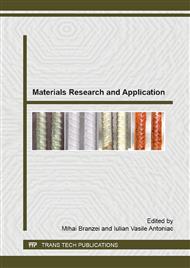[1]
Iversen E, Lykke A, Hensler M, Jorgensen L. Abdominal wall hernia repair with a composite ePTFE/polypropylene mesh: clinical outcome and quality of life in 152 patients. Hernia [serial online]. December 2010; 14(6): 555-560.
DOI: 10.1007/s10029-010-0729-1
Google Scholar
[2]
Binnebösel M, Von Trotha K, Jansen P, Conze J, Neumann U, Junge K. Biocompatibility of prosthetic meshes in abdominal surgery. Seminars In Immunopathology [serial online]. September 2011; 33(3): 235-243.
DOI: 10.1007/s00281-010-0237-5
Google Scholar
[3]
Klinge U, Dietz U, Fet N, Klosterhalfen B. Characterisation of the cellular infiltrate in the foreign body granuloma of textile meshes with its impact on collagen deposition. Hernia: The Journal Of Hernias And Abdominal Wall Surgery [serial online]. August 2014; 18(4): 571-578.
DOI: 10.1007/s10029-014-1220-1
Google Scholar
[4]
Eriksen J, Gögenur I, Rosenberg J. Choice of mesh for laparoscopic ventral hernia repair. Hernia: The Journal Of Hernias And Abdominal Wall Surgery [serial online]. December 2007; 11(6): 481-492.
DOI: 10.1007/s10029-007-0282-8
Google Scholar
[5]
Coda A, Lamberti R, Martorana S. Classification of prosthetics used in hernia repair based on weight and biomaterial. Hernia: The Journal Of Hernias And Abdominal Wall Surgery [serial online]. February 2012; 16(1): 9-20.
DOI: 10.1007/s10029-011-0868-z
Google Scholar
[6]
Gonzalez R, Ramshaw B. Comparison of Tissue Integration between Polyester and Polypropylene Prostheses in the Preperitoneal Space. American Surgeon [serial online]. June 2003; 69(6): 471.
DOI: 10.1177/000313480306900604
Google Scholar
[7]
Klinge U, Klosterhalfen B, Müller M, Schumpelick V. Foreign body reaction to meshes used for the repair of abdominal wall hernias. The European Journal Of Surgery = Acta Chirurgica [serial online]. July 1999; 165(7): 665-673.
DOI: 10.1080/11024159950189726
Google Scholar
[8]
Tolino M, Tripoloni D, Ratto R, Garcia M. Infections associated with prosthetic repairs of abdominal wall hernias: pathology, management and results. Hernia: The Journal Of Hernias And Abdominal Wall Surgery [serial online]. December 2009; 13(6): 631-637.
DOI: 10.1007/s10029-009-0541-y
Google Scholar
[9]
Deysine M. Infections associated with surgical implants. The New England Journal Of Medicine [serial online]. July 8, 2004; 351(2): 193-195. Available from: MEDLINE with Full Text, Ipswich, MA. Accessed January 7, (2015).
Google Scholar
[10]
Klosterhalfen B, Junge K, Hermanns B, Klinge U. Influence of implantation interval on the long-term biocompatibility of surgical mesh. British Journal Of Surgery [serial online]. August 2002; 89(8): 1043-1048.
DOI: 10.1046/j.1365-2168.2002.02149.x
Google Scholar
[11]
Junge K, Rosch R, Klosterhalfen B, et al. Influence of polyglecaprone 25 (Monocryl) supplementation on the biocompatibility of a polypropylene mesh for hernia repair. Hernia: The Journal Of Hernias And Abdominal Wall Surgery [serial online]. October 2005; 9(3): 212-217.
DOI: 10.1007/s10029-004-0315-5
Google Scholar
[12]
Junge K, Binnebösel M, Lynen Jansen P, et al. Mesh biocompatibility: effects of cellular inflammation and tissue remodelling. Langenbeck's Archives Of Surgery [serial online]. February 2012; 397(2): 255-270.
DOI: 10.1007/s00423-011-0780-0
Google Scholar
[13]
Klinge U, Klosterhalfen B. Modified classification of surgical meshes for hernia repair based on the analyses of 1, 000 explanted meshes. Hernia: The Journal Of Hernias And Abdominal Wall Surgery [serial online]. June 2012; 16(3): 251-258.
DOI: 10.1007/s10029-012-0913-6
Google Scholar
[14]
Bisgaard T, Kehlet H, Jorgensen L, et al. Nationwide study of early outcomes after incisional hernia repair. British Journal Of Surgery [serial online]. December 2009; 96(12): 1452-1457.
DOI: 10.1002/bjs.6728
Google Scholar
[15]
Deysine M. Pathophysiology, prevention, and management of prosthetic infections in hernia surgery. The Surgical Clinics Of North America [serial online]. December 1998; 78(6): 1105.
DOI: 10.1016/s0039-6109(05)70372-8
Google Scholar
[16]
Deysine M. Post mesh herniorrhaphy infection control: are we doing all we can?. Hernia: The Journal Of Hernias And Abdominal Wall Surgery [serial online]. May 2004; 8(2): 90-91.
DOI: 10.1007/s10029-003-0176-3
Google Scholar
[17]
Bellon J, Rodriguez M, Garcia-Honduvilla N, Gomez-Gil V, Pascual G, Bujan J. Postimplant behavior of lightweight polypropylene meshes in an experimental model of abdominal hernia. Journal Of Investigative Surgery: The Official Journal Of The Academy Of Surgical Research [serial online]. September 2008; 21(5): 280-287.
DOI: 10.1080/08941930802029937
Google Scholar
[18]
Bellón J, Rodríguez M, Gómez-Gil V, Sotomayor S, Buján J, Pascual G. Postimplant intraperitoneal behavior of collagen-based meshes followed by laparoscopy. Surgical Endoscopy [serial online]. January 2012; 26(1): 27-35.
DOI: 10.1007/s00464-011-1823-x
Google Scholar
[19]
Klinge U, Klosterhalfen B, Öttinger A, Junge K, Schumpelick V. PVDF as a new polymer for the construction of surgical meshes. Biomaterials [serial online]. August 15, 2002; 23(16): 3487-3493.
DOI: 10.1016/s0142-9612(02)00070-4
Google Scholar
[20]
Canonico S, Benevento R, Selvaggi F, et al. Sutureless fixation with fibrin glue of lightweight mesh in open inguinal hernia repair: effect on postoperative pain: a double-blind, randomized trial versus standard heavyweight mesh. Surgery [serial online]. January 2013; 153(1): 126-130.
DOI: 10.1016/j.surg.2012.06.024
Google Scholar


